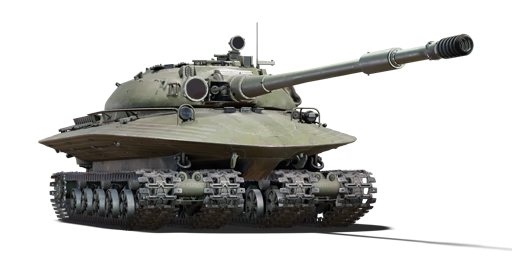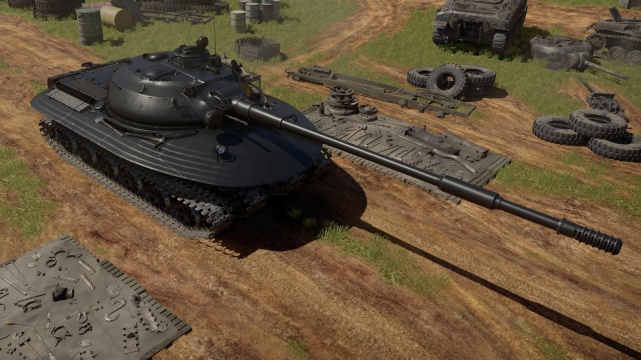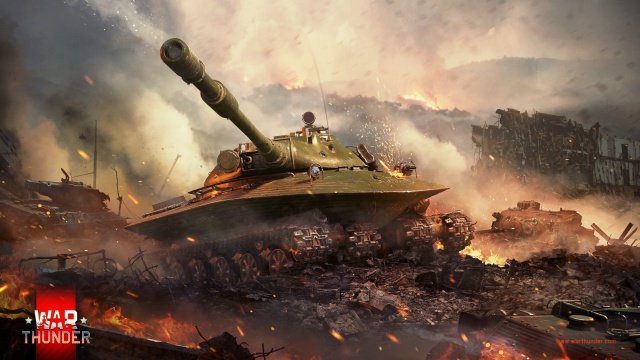Difference between revisions of "Object 279"
(→Survivability and armour: Corrected typo) |
m (→Pros and cons) (Tag: Visual edit) |
||
| Line 185: | Line 185: | ||
* Fuel-tanks are self-sealing and will extinguish by themselves without incurring damage | * Fuel-tanks are self-sealing and will extinguish by themselves without incurring damage | ||
* Extremely angled and thick cast armour | * Extremely angled and thick cast armour | ||
| − | * Quick reloading speed | + | * Quick reloading speed, first stage ammo consists of a 13 shell auto loader |
'''Cons:''' | '''Cons:''' | ||
| Line 193: | Line 193: | ||
* Very vulnerable to high calibre HE; pylons connecting tank to tracks make for ''very'' appealing targets for such shells | * Very vulnerable to high calibre HE; pylons connecting tank to tracks make for ''very'' appealing targets for such shells | ||
* Engine fires still require FPE | * Engine fires still require FPE | ||
| − | |||
== History == | == History == | ||
| Line 210: | Line 209: | ||
== See also == | == See also == | ||
''Links to the articles on the War Thunder Wiki that you think will be useful for the reader, for example:'' | ''Links to the articles on the War Thunder Wiki that you think will be useful for the reader, for example:'' | ||
| + | |||
* ''reference to the series of the vehicles;'' | * ''reference to the series of the vehicles;'' | ||
* ''links to approximate analogues of other nations and research trees.'' | * ''links to approximate analogues of other nations and research trees.'' | ||
| Line 218: | Line 218: | ||
* ''encyclopedia page on the tank;'' | * ''encyclopedia page on the tank;'' | ||
* ''other literature.'' --> | * ''other literature.'' --> | ||
| + | |||
* [[wikipedia:Object_279|[Wikipedia] Object 279]] | * [[wikipedia:Object_279|[Wikipedia] Object 279]] | ||
{{USSR heavy tanks}} | {{USSR heavy tanks}} | ||
Revision as of 02:05, 29 June 2020
Contents
Description
The Object 279 is a gift rank Soviet heavy tank
with a battle rating of (AB), (RB), and (SB). It was introduced during Update 1.97 "Viking Fury" as a reward for the "Space Race" event.
General info
Survivability and armour
Getting the exact armour thickness of this tank is quite tricky due to the cast nature of its outer shell. But that won't affect the way one may view its survivability, at the very least the armour thickness of the hull may reach up to 300 mm when faced frontally (excluding the driver's hatch, which is 30 mm flat). The middle of the hull (area below the driver's hatch) is the least angled part of the tank besides the tank's rear, and thus is usually the first spot that is shot at, whereas the sides surrounding this area (left and right parts of the hull when faced front) can reach absurd amounts of thickness, even reaching up to 1000 mm due to extreme angles.
The turret is arguably the most armoured part of this tank. Again, getting the exact thickness is difficult but it is guaranteed to be very hard to penetrate, even APFSDS shells will have trouble going through certain spots of this tank. The only prominent weak spot of this turret is the mantlet and machine gun port on the left side of the gun when faced front. Going through the mantlet will more or less only break the gun breech in most cases. One usually shoots the rear side of the turret because that is where the ready rack is located.
It is important to mention the cramped crew spacing. It is like most, if not all, Soviet tank designs where the engineers threw the entire concept of crew comfort out the window. This is important when it comes to the survivability of the crew whenever a shell is able to punch through its stubborn shell. The crew spacing is quite cramped and thus more susceptible to shrapnel damage caused by spalling. On the bright side, most nations have given up on the concept of APHE shell at around this tank's BR so the chances of one-shots are reduced to a degree. Though there are unlucky times when a shell goes through the plate and hit the ready rack behind the gun breech.
Another feature worth mentioning on this vehicle are its self sealing fuel tanks located along the tracks of the tank. To the inexperienced player, these may be an appealing target but that is not recommended unless the intention was to interrupt a repair, most of the time this will only cause a fire and maybe break some tracks (causing a fire is pointless due to the self extinguishing feature). A more recommended target on the side is the bulge made to accommodate the size of the turret (this bulge is also present on the T-62), it is the flattest part of the tank, besides the rear.
All around, this tank is a very hard nut to crack but one should not rely on its armour to stop incoming projectiles. It shares at least some similarities with the T-10M and it has a similar playstyle.
Mobility
| Game Mode | Max Speed (km/h) | Weight (tons) | Engine power (horsepower) | Power-to-weight ratio (hp/ton) | |||
|---|---|---|---|---|---|---|---|
| Forward | Reverse | Stock | Upgraded | Stock | Upgraded | ||
| Arcade | Expression error: Unexpected * operator. | 1,291 | Expression error: Unexpected round operator. | __.__ | |||
| Realistic | 884 | Expression error: Unexpected round operator. | __.__ | ||||
Armaments
Main armament
Give the reader information about the characteristics of the main gun. Assess its effectiveness in a battle based on the reloading speed, ballistics and the power of shells. Do not forget about the flexibility of the fire, that is how quickly the cannon can be aimed at the target, open fire on it and aim at another enemy. Add a link to the main article on the gun: {{main|Name of the weapon}}. Describe in general terms the ammunition available for the main gun. Give advice on how to use them and how to fill the ammunition storage.
| 130 mm M-65 | Turret rotation speed (°/s) | Reloading rate (seconds) | |||||||||||
|---|---|---|---|---|---|---|---|---|---|---|---|---|---|
| Mode | Capacity | Vertical | Horizontal | Stabilizer | Stock | Upgraded | Full | Expert | Aced | Stock | Full | Expert | Aced |
| Arcade | 40 | -5°/+18° | ±180° | Two-plane | 14.6 | __.__ | __.__ | __.__ | __.__ | 11.1 | _.__ | _.__ | _.__ |
| Realistic | 10.7 | __.__ | __.__ | __.__ | __.__ | ||||||||
Ammunition
| Penetration statistics | |||||||
|---|---|---|---|---|---|---|---|
| Ammunition | Type of warhead |
Penetration @ 0° Angle of Attack (mm) | |||||
| 10 m | 100 m | 500 m | 1,000 m | 1,500 m | 2,000 m | ||
| BR-482B | APCBC | 312 | 309 | 294 | 277 | 260 | 245 |
| OF-482M | HE | 31 | 31 | 31 | 31 | 31 | 31 |
| Shell details | |||||||||
|---|---|---|---|---|---|---|---|---|---|
| Ammunition | Type of warhead |
Velocity (m/s) |
Projectile Mass (kg) |
Fuse delay (m) |
Fuse sensitivity (mm) |
Explosive Mass (TNT equivalent) (g) |
Ricochet | ||
| 0% | 50% | 100% | |||||||
| BR-482B | APCBC | 900 | 33.30 | 1.2 | 19.0 | 177.1 | 48° | 63° | 71° |
| OF-482M | HE | 900 | 33.70 | 0.0 | N/A | 2,650 | 79° | 80° | 81° |
Ammo racks
| Full ammo |
1st rack empty |
2nd rack empty |
3rd rack empty |
4th rack empty |
5th rack empty |
6th rack empty |
Visual discrepancy |
|---|---|---|---|---|---|---|---|
| 40 | __ (+__) | __ (+__) | __ (+__) | __ (+__) | __ (+__) | __ (+__) | __ |
Optics
| Object 279 Optics | ||
|---|---|---|
| Default magnification | Maximum magnification | |
| Main Gun optics | x7.2 | x8.0 |
| Comparable optics | ___ | |
Machine guns
| 14.5 mm KPVT | ||||
|---|---|---|---|---|
| Mount | Capacity (Belt) | Fire rate | Vertical | Horizontal |
| Coaxial | 800 (50) | 600 | N/A | N/A |
Usage in battles
Describe the tactics of playing in the vehicle, the features of using vehicles in the team and advice on tactics. Refrain from creating a "guide" - do not impose a single point of view but instead give the reader food for thought. Describe the most dangerous enemies and give recommendations on fighting them. If necessary, note the specifics of the game in different modes (AB, RB, SB).
Modules
| Tier | Mobility | Protection | Firepower | ||
|---|---|---|---|---|---|
| I | Tracks | Parts | Horizontal Drive | ||
| II | Suspension | Brake System | FPE | Adjustment of Fire | |
| III | Filters | Crew Replenishment | Elevation Mechanism | ||
| IV | Transmission | Engine | ESS | Rangefinder | NVD |
Pros and cons
Pros:
- Great 130 mm gun; able to one-shot majority of the enemy tanks.
- Main gun has a two-plane stabilizer
- Great mobility
- Rangefinder and NVD
- Coaxial 14.5 mm machine gun is great for dealing with light vehicles and aircraft
- Fuel-tanks are self-sealing and will extinguish by themselves without incurring damage
- Extremely angled and thick cast armour
- Quick reloading speed, first stage ammo consists of a 13 shell auto loader
Cons:
- Inadequate turret traverse speed
- Inadequate depression angle, a feature shared by all Soviet tanks
- Very vulnerable to high calibre HE; pylons connecting tank to tracks make for very appealing targets for such shells
- Engine fires still require FPE
History
The Object 279 Kotin was conceived in 1959. It was supposed to be a breakthrough tank that was also able to withstand a nuclear blast's shockwave. The development of the design started at the Kirov Plant in Leningrad, the head designer was L. Troyanov. The project was started in 1957 under the requirements of 1956. The pre-production Object 279 was completed at the end of 1959.
Although 3 vehicles were built in total, the project was later abandoned in favour of lighter vehicles which ended the Soviet heavy tank programs, due to Soviet leader at the time, Nikita Khrushchev's decision on July 22, 1960, to stop the production of tanks weighing more than 50 metric tons, in favour of smaller and lighter tanks.
Media
See also
Links to the articles on the War Thunder Wiki that you think will be useful for the reader, for example:
- reference to the series of the vehicles;
- links to approximate analogues of other nations and research trees.
External links
| USSR heavy tanks | |
|---|---|
| KV-1 | KV-1 (L-11) · KV-1 (ZiS-5) · KV-1E · KV-1S |
| KV-2 | KV-2 (1939) · KV-2 (1940) · KV-2 (ZiS-6) |
| Other KVs | KV-85 · KV-122 · KV-220 |
| IS-1/2 | IS-1 · IS-2 · IS-2 (1944) · IS-2 No.321 · IS-2 "Revenge" · Object 248 |
| Other IS tanks | IS-3 · IS-4M · IS-6 · IS-7 |
| T-10 | T-10A · T-10M |
| Multi-turreted | T-35 · SMK |
| Other | Object 279 |
| Lend-Lease | ▂MK-II "Matilda" |







